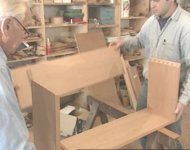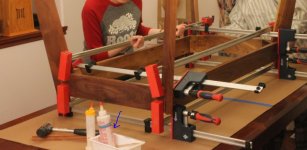I normally use Titebond III, but I have a dresser to glue up soon -- basically two side frames with three shelf pieces, total of 28 loose tenons, and the thought of trying to spread the adhesive, align the pieces and setting the clamps, in 10 minutes, is rather intimidating.
I sometimes use PL Premium on wood, but in this case, I expect the material expansion would be a problem for this project.
Lee Valley's Cabinetmaker's glue specifies 15-20 minute open time, but its a PVA glue so I wonder if its really any different than the Titebond.
Maybe I should be using epoxy ?
What do you guys use when you need a little more working time ?
I sometimes use PL Premium on wood, but in this case, I expect the material expansion would be a problem for this project.
Lee Valley's Cabinetmaker's glue specifies 15-20 minute open time, but its a PVA glue so I wonder if its really any different than the Titebond.
Maybe I should be using epoxy ?
What do you guys use when you need a little more working time ?


